|
Use this link to add your email
address to the RARWRITER Publishing Group mailing list for
updates on activities associated with
the
Creative Culture and Revolution
Culture journals,
and other RARWRITER Publishing Group interests.
ABOUT RAR: For those of
you new to this site, "RAR" is Rick Alan Rice, the publisher
of the RARWRITER Publishing Group websites.
Use this link to visit the
RAR music page, which features original music
compositions and other.
Use this link
to visit Rick Alan Rice's publications page, which
features excerpts from novels and other.
RARADIO
(Click here)
"On to the
Next One" by
Jacqueline Van Bierk
"I See You
Tiger" by Via Tania
"Lost the
Plot" by Amoureux"
Bright Eyes,
Black Soul" by The Lovers
Key
"Cool Thing"
by Sassparilla
"These Halls I Dwell"
by Michael Butler
"St. Francis"by
Tom Russell & Gretchen Peters, performance by Gretchen
Peters and Barry Walsh;
"Who Do You
Love?"by Elizabeth Kay;
"Rebirth"by
Caterpillars;
"Monica's
Frock" by
Signel-Z;
"Natural
Disasters" by
Corey Landis;
"1,000
Leather Tassels" by
The Blank Tapes;
"We Are All Stone" and "Those
Machines" by Outer
Minds;
"Another Dream" by MMOSS;
"Susannah" by Woolen
Kits;
Jim Morrison, Elvis Presley,
Michael Jackson and other dead celebrities / news by A
SECRET PARTY;
"I Miss the Day" by My
Secret Island,
"Carriers of Light" by Brendan
James;
"The Last Time" by Model
Stranger;
"Last Call" by Jay;
"Darkness" by Leonard
Cohen;
"Sweetbread" by Simian
Mobile Disco and
"Keep You" fromActress off
the Chronicle movie soundtrack;
"Goodbye to
Love" from October
Dawn;
Trouble in
Mind 2011 label
sampler;
Black Box
Revelation Live
on Minnesota Public Radio;
Apteka "Striking
Violet";
Mikal
Cronin's "Apathy"
and "Get Along";
Dana
deChaby's progressive
rock
_______
MUSIC LINKS
"Music Hot Spots"
LOS ANGELES
SAN FRANCISCO
NEW YORK CITY
NASHVILLE
CHICAGO
AUSTIN
DENVER-BOULDER
MINNESOTA
SEATTLE
NEW ORLEANS
PHILADELPHIA
BOSTON
PORTLAND
DETROIT
MEMPHIS
PACIFIC NORTHWEST
FLORIDA
ARIZONA
INTERNATIONAL LINKS
UNITED KINGDOM
EUROPE
JAPAN
SCANDANAVIA
AUSTRALIA
CANADA
ASIA
|
|
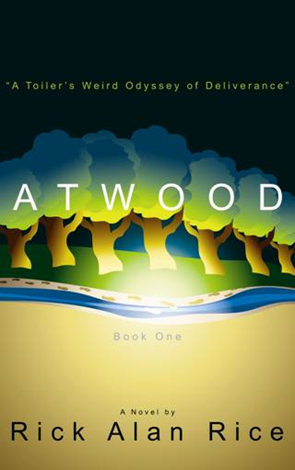
ATWOOD - "A Toiler's Weird Odyssey of Deliverance" -AVAILABLE
NOW FOR KINDLE (INCLUDING KINDLE COMPUTER APPS) FROM
AMAZON.COM. Use
this link.
CCJ Publisher Rick Alan Rice dissects
the building of America in a trilogy of novels
collectively calledATWOOD. Book One explores
the development of the American West through the
lens of public policy, land planning, municipal
development, and governance as it played out in one
of the new counties of Kansas in the latter half of
the 19th Century. The novel focuses on the religious
and cultural traditions that imbued the American
Midwest with a special character that continues to
have a profound effect on American politics to this
day. Book One creates an understanding about
America's cultural foundations that is further
explored in books two and three that further trace
the historical-cultural-spiritual development of one
isolated county on the Great Plains that stands as
an icon in the development of a certain brand of
American character. That's the serious stuff viewed
from high altitude. The story itself gets down and
dirty with the supernatural, which in ATWOOD
- A Toiler's Weird Odyssey of Deliveranceis the
outfall of misfires in human interactions, from the
monumental to the sublime. The
book features the epic poem "The
Toiler" as
well as artwork by New Mexico artist Richard
Padilla.
Elmore Leonard
Meets Larry McMurtry
Western Crime
Novel
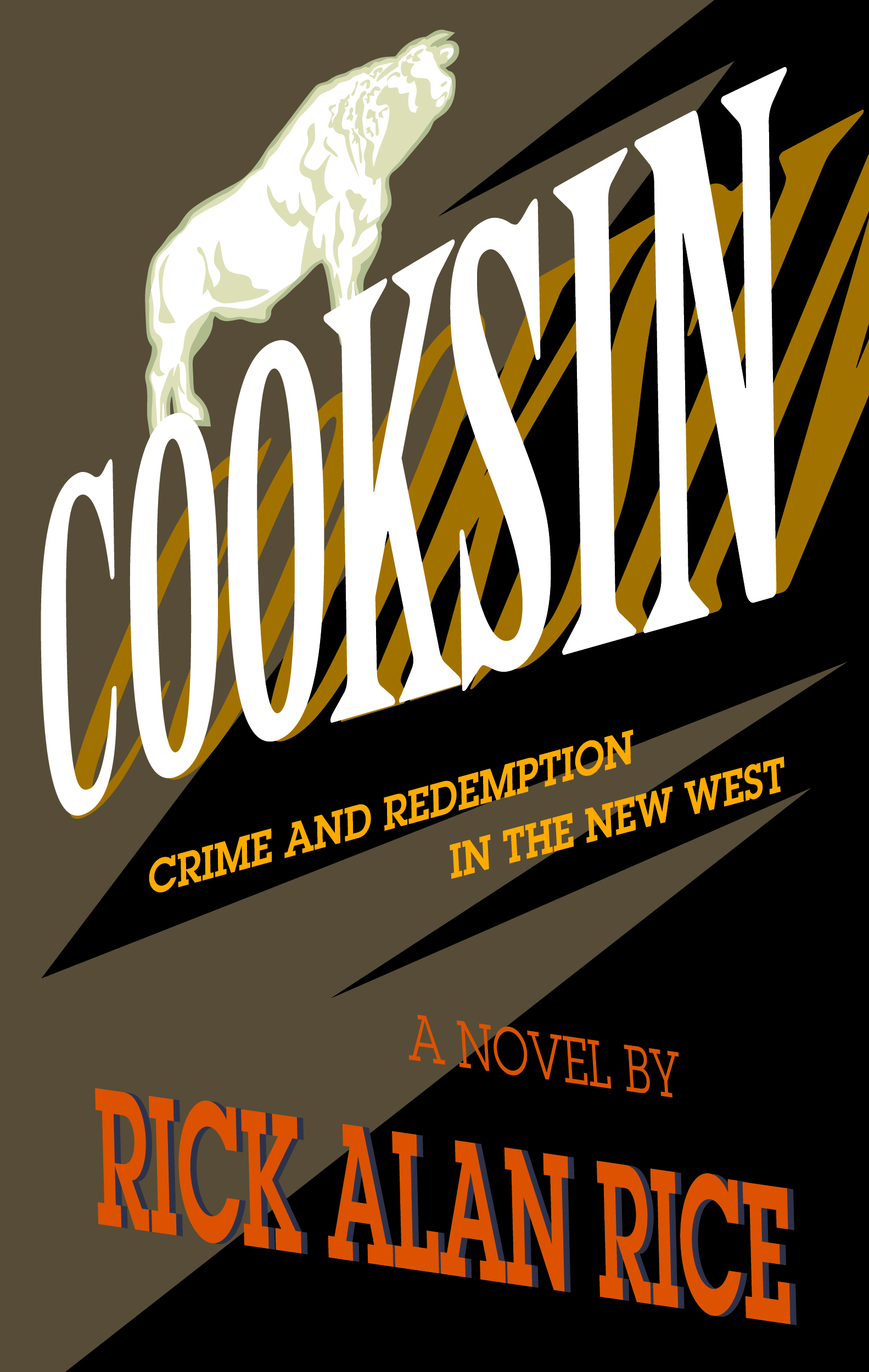
I am offering another
novel through Amazon's Kindle Direct Publishing service.
Cooksin is the story of a criminal syndicate that sets its
sights on a ranching/farming community in Weld County, Colorado,
1950. The perpetrators of the criminal enterprise steal farm
equipment, slaughter cattle, and rob the personal property of
individuals whose assets have been inventoried in advance and
distributed through a vast system of illegal commerce.
It is a ripping good yarn, filled
with suspense and intrigue. This was designed intentionally to
pay homage to the type of creative works being produced in 1950,
when the story is set. Richard Padilla
has done his usually brilliant work in capturing the look and feel of
a certain type of crime fiction being produced in that era. The
whole thing has the feel of those black & white films you see on
Turner Movie Classics, and the writing will remind you a little
of Elmore Leonard, whose earliest works were westerns.
Use this link.
EXPLORE THE KINDLE
BOOK LIBRARY
If you have not explored the books
available from Amazon.com's Kindle Publishing
division you would do yourself a favor to do so. You
will find classic literature there, as well as tons
of privately published books of every kind. A lot of
it is awful, like a lot of traditionally published
books are awful, but some are truly classics. You
can get the entire collection of Shakespeare's works
for two bucks.
You do not need to buy a Kindle to
take advantage of this low-cost library. Use
this link to go to an Amazon.com page from which you
can download for free a Kindle App for
your computer, tablet, or phone.
Amazon is the largest,
but far from the only digital publisher. You can
find similar treasure troves atNOOK
Press (the
Barnes & Noble site), Lulu,
and others. |
|
|
|
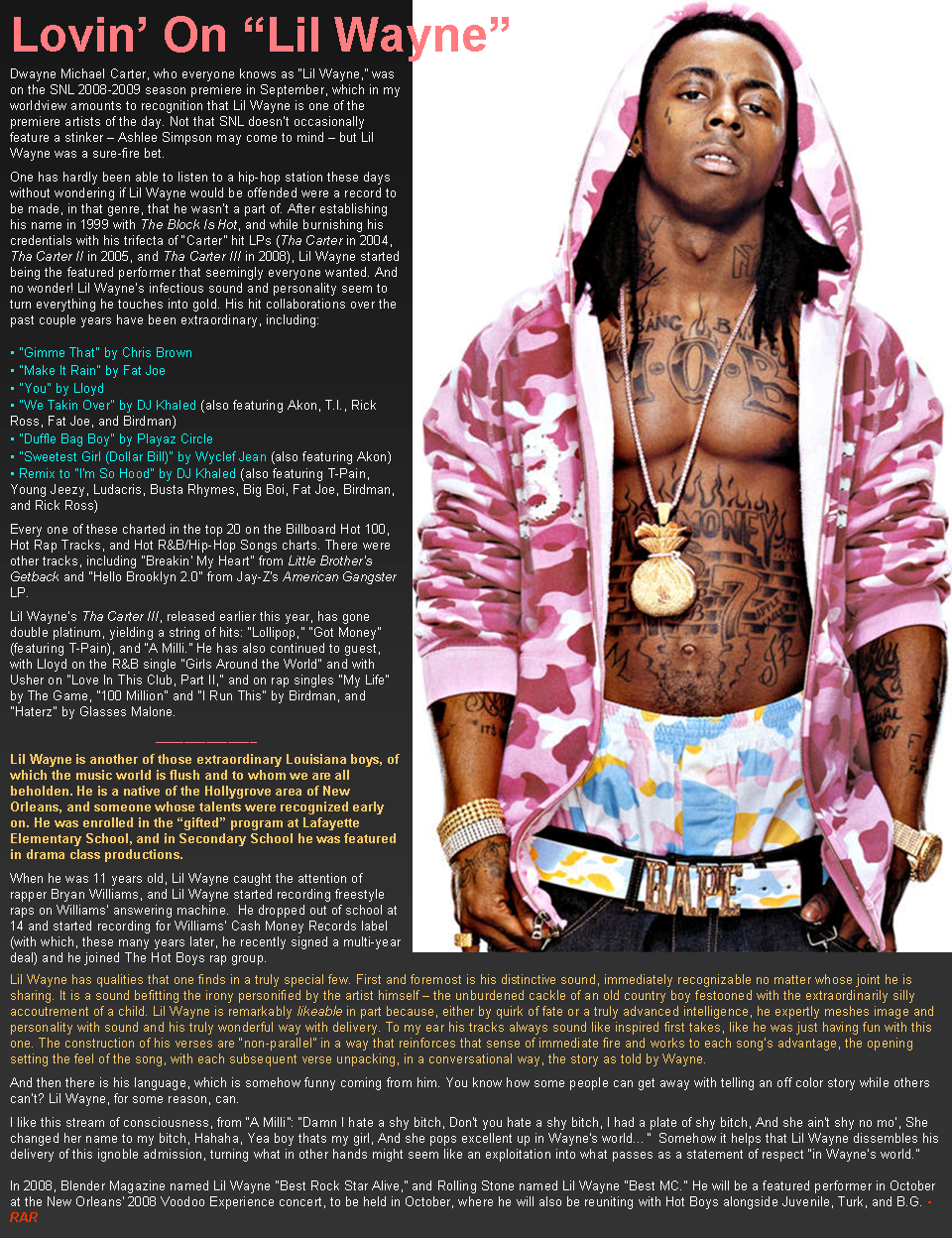
|
www.lsue.edu/acadgate/music/cjchenier.htm
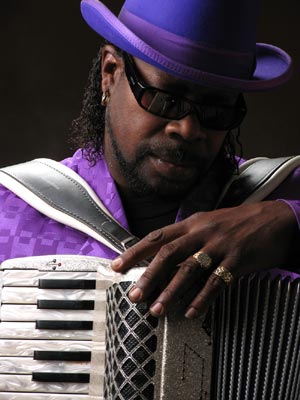 Clayton
Joseph (C.J.) Chenier took control of a great franchise
in the music industry when he received the mantle passed down by his
father, the "King of Zydeco," the late Clifton Chenier. Clayton
Joseph (C.J.) Chenier took control of a great franchise
in the music industry when he received the mantle passed down by his
father, the "King of Zydeco," the late Clifton Chenier.
The
process of inheritance began in 1978 when C.J. joined his father's band
as a saxophone player. The inclusion in his father's life was late in
coming. C.J. grew up with his mother in Texas, at a distance from Clifton, whose home
was in Lafayette, Louisiana. They saw each other occasionally when C.J.
was growing up. Whatever, they shared the music gene. C.J. developed
a talent for sax and keyboards, which was his ticket into the Red Hot
Louisiana Band. He joined as a side player and became immersed in a type of music he had not played before - zydeco,
his father's music.
Over the years, C.J. began to
play a more prominent role in the Red Hots, particularly as Clifton's
health waned. C.J. picked up the accordion and started filling in for his
ailing father as the band's frontman. In 1987, when Clifton passed away,
the Red Hot Louisiana Band became C.J.'s.
One by one the original
members of the band were replaced by a new generation of players. C.J.
sounds a lot like Clifton and carries on some of the same repertoire, but
C.J. is a songwriter in his own right. Few may remember that Clifton Chenier was an
R&B act until the mid-50s, when he popularized the tune “Les
Haricots Sont Pas Salés” (which translates to “The snap beans
aren’t salty”), a poor person's lament to insufficiency. Clifton's
zydeco was uptempo, but more blues oriented than today's zydeco, which has
continued to expand through incorporation of soul, rap and reggae
influences.
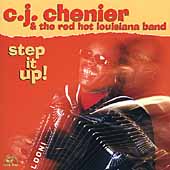 Recording on Alligator
Records, the Red Hot Louisiana Band under C.J.'s leadership has released a
new LP, featuring C.J.'s original material mixed with other tunes, every
few years. They released Step
It Up! (2001), The Big Squeeze (1996) and Too Much Fun (1995).
The first C.J.-led album, My Baby Don't Wear No Shoes, recorded
in 1988 and released by Arhoolie on CD in 1992, includes the classic
Clifton Chenier song "I'm Coming Home." C.J. Chenier also
recorded two albums for the alternative rock label Slash: Hot Rod
(1990) and I Ain't No Playboy (1992). Recording on Alligator
Records, the Red Hot Louisiana Band under C.J.'s leadership has released a
new LP, featuring C.J.'s original material mixed with other tunes, every
few years. They released Step
It Up! (2001), The Big Squeeze (1996) and Too Much Fun (1995).
The first C.J.-led album, My Baby Don't Wear No Shoes, recorded
in 1988 and released by Arhoolie on CD in 1992, includes the classic
Clifton Chenier song "I'm Coming Home." C.J. Chenier also
recorded two albums for the alternative rock label Slash: Hot Rod
(1990) and I Ain't No Playboy (1992).
|
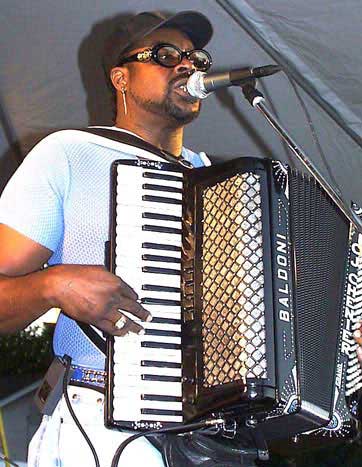
Clifton Chenier popularized zydeco and
C.J. has continued the legacy as a foremost ambassador of the style. Another key emissary has been
Buckwheat Zydeco, profiled on this page below, who played the B3 in Clifton Chenier's unit
but now has a great career as an accordion playing front man.
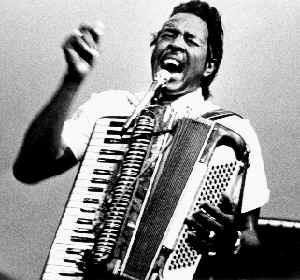
C.J.'s daddy Clifton in a 1973 photo.
|
|
Louisiana
is like no other place in the United States because it was populated in a
unique way. Where much of the United States were populated through a
steady east to west expansion, with the entry points being on the eastern
seaboard, Louisiana took exiles at its own ports of entry along its
gulf-fronting southern coast. In the mid-18th century there was an influx
of exiled "Acadians," French-speaking refugees expulsed from
Nova Scotia by the British, who brought with them an ancient traditional
music suffused with the bluesy despair of displaced people.
In
southern Louisiana, the Acadians intermingled with immigrants of African
descent - Creoles - and a distinct new culture developed from the
inter-marriage: Cajun. The Creoles brought instrumentation to the
Acadians' traditional sound, but the sound wasn't what it is today until
the late 1800s when the accordion entered the picture. Affordable
accordions were imported into the area and quickly became incorporated
into the sound. The discovery in the 1930s of oil in Louisiana further
influenced what had been a remarkably insular bubble of French-African
culture, and with the influx of "Anglos" came guitar and
fiddle-based country western music. For a brief period before and during
World War II the "traditional" accordion sound of Cajun music
disappeared, but veterans returning from the war seemed to yearn for the
earlier sound and the button accordion re-emerged as the lead instrument
subordinating the guitar and fiddle, lap steel, bass and drums. Cajun
music was fully formed by mid-century as an amalgam of Acadian
traditional, African blues and American Country Western.
Zydeco,
while also rooted in Creole culture, is a more recent innovation, dating
back only to the 1950s. The word zydeco is generally believed to be
derived from the French pronunciation of "les haricots"
("the beans"), "lay zarico,” which morphed into "le zydeco."
At its core, zydeco (which as an attributive noun is lower cased, while
Cajun, referencing a culture, is properly upper cased) is built on the
hand clap and foot stomp music of African field laborers. It is more
uptempo than Cajun music, which tends toward more romantic melodic sounds,
while zydeco is rhythmic dance music. Zydeco is not a fiddle music and
augments accordion, piano, guitar, drum and bass with the rub board, or frottoir.
Here again, zydeco is an innovation, the original domestic washboard
morphing into a sheet of corrugated metal worn like a vest that players
scratch with spoons to create rhythmic sounds. Here again, the button
accordion is often used, but leading zydeco stars like Clifton and C.J.
Chenier and Buckwheat Zydeco all play piano accordion exclusively.
Besides
instrumentation variations, each style
has its own dance styles, the waltz being a crossover dance. Cajun dance
moves around a floor and includes 2-steps and jitterbugs similar to
country western dance, where zydeco dance is generally done from a closed
position.
There
are many great resources to learn more about these rich forms of Louisiana
music. One on line resource you might check is http://rochesterzydeco.com/cajunzydeco.html |
|
www.mamouplayboys.com
STEVE
RILEY AND THE MAMOU PLAYBOYS
have been carrying the torch of Cajun music since 1988. That’s when
Steve Riley, from the prairie town of Mamou, Louisiana, founded his band,
inspired by the music of the Balfa
Brothers, who are foremost figures in the Louisiana traditional French
language music.
Steve dedicated himself to learning the single-row diatonic
accordion that is sine qua non to the Cajun sound. The particular
instrument he plays was crafted for him by famed accordionist Marc Savoy, of the famous Savoy
family, another pillar of the Cajun music community. (I’ll come back
to this in a moment.) Prior to starting his own unit, he played with Dewey
Balfa and the Balfa Brothers,
which is how he built his extraordinary songbook of French tunes. Steve
founded the Mamou Playboys with violinist friend David
Greely, who also apprenticed with the Balfas.
Baton Rouge-area native David
Greely has sought the music and language of his ancestors by traveling
through France, Acadia and Louisiana to study Acadian history. He was
honored by the Louisiana Division of the Arts in 2004 with an “Artist
Fellowship Award in Folklife” for his dedication and stewardship of the
Acadian culture.
The Mamou Playboys got a big boost musically when guitar
great Sam Broussard joined the
band in 2001. A Southern Louisiana boy, Sam comes more of a rock place but
he is grew up with Cajun music, understands it well, and knows how to fire
it up with his electric augmentations to the traditional sound. Sam, as
has been reported here on the Links, was featured last year on the LP that
Ann Savoy, of the prominent Cajun Savoy family mentioned above, did
with ‘60s-‘70s heartthrob Linda
Ronstadt, which was performed largely in French.
The Mamou Playboys are rounded out by another couple
legitimate Cajuns – Brazos
Huval,
formerly a bassist for zydeco artist Horace
Trahan, and drummer Kevin Dugas,
who began his career at the age of 16 playing with famed Cajun
accordionist and vocalist Belton
Richard. He also worked with Walter
Mouton and the Scott
The
Mamou Playboys specialize in wild flights of musical improvisation over
traditional Lafayette dancehall sounds.
TOP RIGHT: Multi-instrumentalist Steve
Riley fiddles with fiddler David Greely. MIDDLE RIGHT: Steve Riley on
accordion, Sam Broussard on guitar. LOWER MIDDLE RIGHT: Steve Riley at
the mic. BOTTOM RIGHT: Slidin' Sam Broussard. BELOW: Steve Riley and the
Mamou Playboys. |
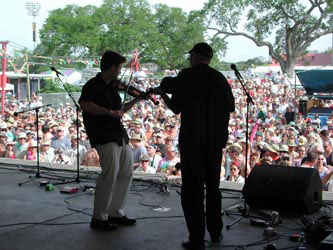
|
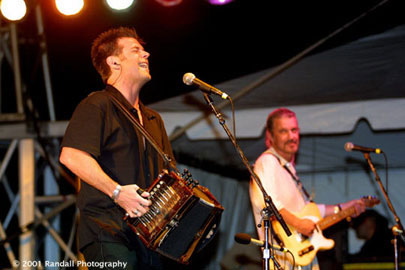 |
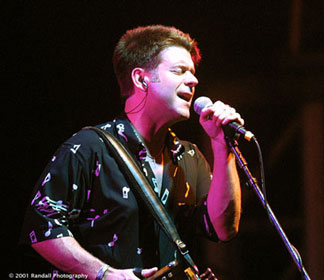 |
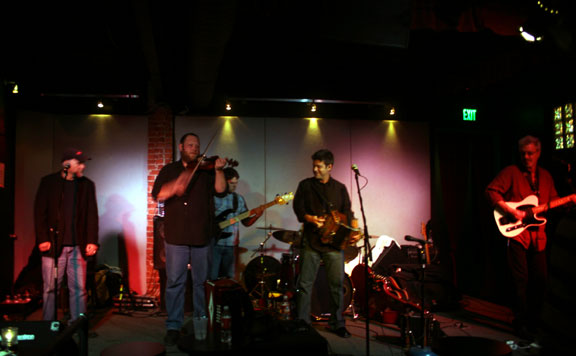 |
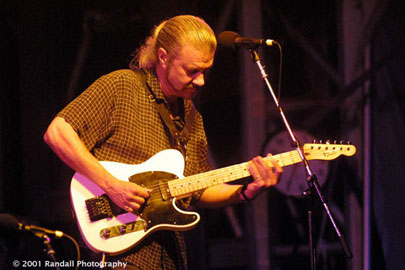 |
| STEVE
RILEY AND THE MAMOU PLAYBOYS NEWS:
The Mamou Playboys were
appearing in February at Connolly's on 45th Street in NYC as part
of the "Let's zydeco" concert series (see www.letszydeco.com).
Riley got a nice writeup in the Night Life Rock and Pop section of the
February 12 (2007) issue of The New Yorker, which in the January 15
(2007) issue ran the following artwork:

When The New Yorker
art staff starts drawing pictures of you or your band, you know you've got
it going on.
|
 |
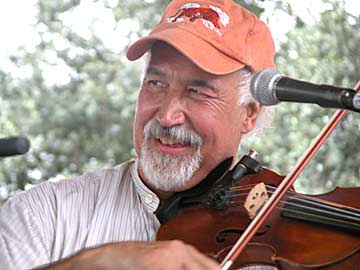 |
The
Cajun Boys of Lafayette
Lafayette, Louisiana high schools
produced four of Cajun music's greatest practitioners when in 1969 they
graduated this mighty quartet featured on the left.
UPPER LEFT: Sonny
Landreth is an acknowledged master of slide guitar, but he
is more than that, having innovated a technique in which he plays chord
forms behind his slide. His legion of admirers includes Eric Clapton, who
calls Sonny "one of the most advanced" guitarists on the planet.
UPPER RIGHT: Michael
Doucet is the leader of the frequently honored group
BeauSoleil. Michael was a roommate at LSU with another Louisiana prodigy,
Steve Conn (featured below).
LOWER LEFT: Zachary
Richard is a poet working in French and English and a
documentary filmmaker, as well as a singer/songwriter. He is a founding
member of Action Cadienne, a group dedicated to the preservation of the
French language in Louisiana.
LOWER RIGHT: Sam
Broussard, featured on this page, has switched roles with
his friend Sonny Landreth in a few bands, including Jimmy Buffet's and
Michael Martin Murphey's. His brilliant album Geeks (2000)
demonstrated the depth of his songwriting and musicianship and won
critical raves. He was the guitarists for the 2006 Linda Ronstadt/Ann
Savoy Cajun album Adieu False Heart.
|
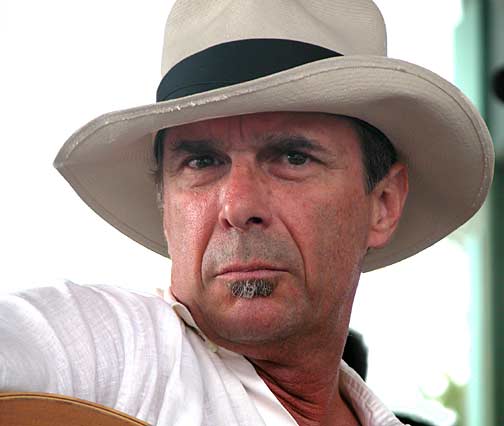 |
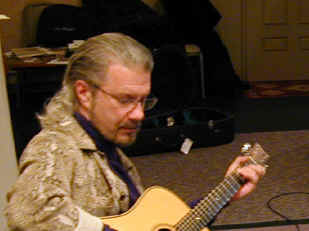 |
|
www.steveconn.com
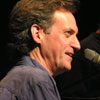 Steve
Conn is all over this
page, playing on tracks for Chris Daniels and contributing a great deal
of the information contained herein. Steve is one of the good guys. He recently returned from
shows in Colorado where he was featured on former Denver Post
Music Critic G. Brown's music series. (Brown is featured on the
Colorado Links.) Steve's longtime collaborator and friend
slide-guitarist Sonny Landreth joined him for his Colorado dates, which
featured his full band playing to sold out shows. Steve
Conn is all over this
page, playing on tracks for Chris Daniels and contributing a great deal
of the information contained herein. Steve is one of the good guys. He recently returned from
shows in Colorado where he was featured on former Denver Post
Music Critic G. Brown's music series. (Brown is featured on the
Colorado Links.) Steve's longtime collaborator and friend
slide-guitarist Sonny Landreth joined him for his Colorado dates, which
featured his full band playing to sold out shows.
As most everyone knows, Steve is the son of
swing violinist "Peanut" Conn, of Bob Wills and the
Texas Playboys fame. Steve has played with Bonnie Raitt, Sonny
Landreth, Kenny Loggins, Nanci Griffith, Kris Kristofferson, Allison
Moorer, Billy Joe Shaver, Mark Knopfler, Dixie Chicks, Albert King, Sheena
Easton, Marshall Crenshaw, Shelby Lynne and many others. The
ridiculously humble multi-instrumentalist received a Grammy nomination for
his piano, harmonica and saxophone work with BeauSoleil, and
another for his accordion work with Arlo Guthrie.
While living in
Boulder in the 1970s and '80s he was involved with several happening acts,
including Fat Chance and his own band Gris-Gris, which
smoked the area for years with the sounds of rockin' New Orleans.
He spent two years as music director for E-Town, a weekly
National Public Radio variety show that integrated the finest Americana,
roots and folk music with environmental education and information. In that
capacity, he worked with James Taylor, Michelle Shocked, Shawn Colvin,
David Wilcox, Maura O'Connell, Emmylou Harris and others. It seems
Steve knows, and is known by, everyone.
Still, a typical Steve Conn lament would
be - "The music business has kicked my ass." Hard to tell
exactly when this happened. Most of the time humble Steve seems to be the
one doing the ass kicking.
|
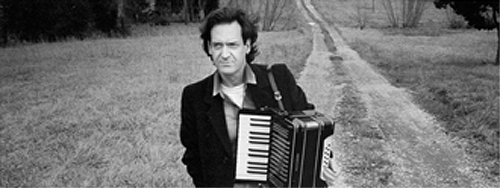
Photo
(left):
Kent Hutslar Photo
(above):
Alan Messer
Photo
(below) by Terri Fensel
|
|
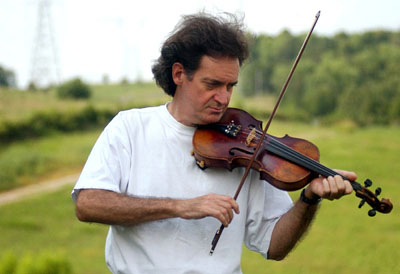
|
|
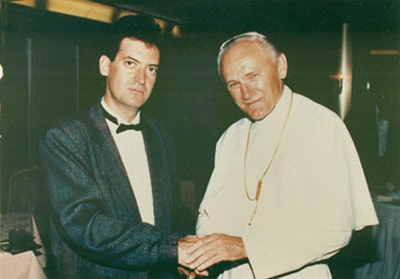
Am
I seeing this funny or does the Pope seem happier
to be in this shot than Steve does? - RAR |
|
STEVE
CONN MP3:
How
Does It Feel - Steve is back to the moral politics theme with this
tune he just posted for download on his website. This song is filled with
outrage - and it grooves! Nashville mates Bryan Owings (drums), Tim
Marks (bass) and Jack Silverman (guitar) joined him in studio.
Silverman's guitar lines are great and Steve is singing really well. (He
deserves some Mary Clayton-Claudia Lanier type back vocals. Give me the
chills.) Steve is thinking about fire and the end of the world.
Katrina
Christmas - Steve wrote and recorded this for Christmas 2005 and offers
it free on his website. It is an acerbic and clever response to the inadequacies
of federal and Louisiana state government efforts to provide assistance to the
displaced people of the Gulf Coast region, and particularly New Orleans. There
have been a lot of "Katrina songs" following last year's devastating
events, but I like Steve's for it's authentic New Orleans "Dr. John"
feel.
Copyright
© Steve Conn, All Rights Reserved
|
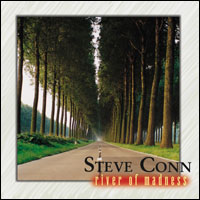
|
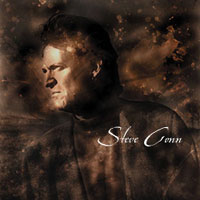
|
|
Steve
has re-released a re-mastered edition of his excellent River of Madness
CD, and also has his 2003 self titled CD, Steve Conn, available.
|
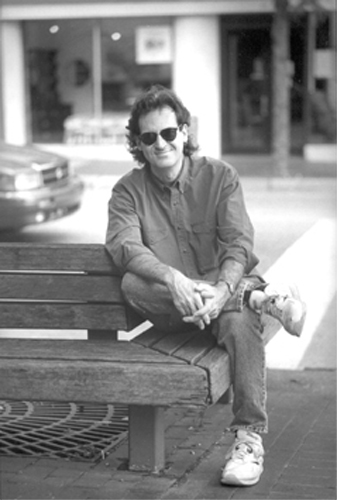 STEVE CONN -
ETOWN'S ORIGINAL MUSIC
DIRECTOR STEVE CONN -
ETOWN'S ORIGINAL MUSIC
DIRECTORThere
is a profile of Nick and Helen
Forster, the co-host and co-producers of the popular "etown"
program, the recorded-live-in-front-of-an-audience interview/performance
show that is carried by over 100 PBS radio affiliates nationwide. Steve
Conn had a hand in the show's success as the original music director.
Steve
writes - "I
was the original music director. The etones were my (former
Gris-Gris)
bass
player, Chris Engleman, and drummer, Steve Ivey. They're the
guys who still play with me when I go back to Colorado, and they're better
than ever. Chris still does the show (etown)."
And
he wrote about his role in producing the weekly musical event - "I helped with every facet of the
music. When we found out who the musical guests were for the upcoming
week, I would get in touch with them or their management (usually the
artist) and find out what songs they wanted to do. They would send me CDs
or cassettes and I would make charts of the tunes. The sound you
hear is me patting myself on the back -- I think I was quite good at the
MD thing. I'm good at making other people look good. But the band
was also stellar."
|
NEIL
YOUNG PAGE OF ANTI-WAR SONGS
http://www.neilyoung.com/lwwtoday/lwwsongspage.html
Steve
Conn's song "How Does It Feel" was doing well on Neil
Young's site where he has invited songwriters to post their anti-war
songs. Well over one thousand songs have been posted, including songs by
some of the biggest names in the music business. It is a fun list to scan
and to pick from. The more recently posted tunes tend to rise more quickly
to the top, which is ordered according to number of plays. |
|
www.sambroussard.com
Sam
Broussard is a marvelous Louisiana prodigy known to all the readers
of this page (I'm guessing). He released a brilliant CD called Geeks
a few years back, then recently sent me a 15-song demo CD - he considers
it "rough" but its smoother than most people's master recordings
- that ensures that we are going to hear great music from Sam for a long
time to come. He is currently guitarist for the Grammy nominated Cajun band Steve
Riley and the Mamou Playboys, and wrote half the songs on their most recent
CD release. (See the Steve Riley profile below.) He has
also been performing recently with Linda Ronstadt. He was
featured on her recent Vanguard Records release Adieu False Heart,
with Cajun music artist Ann Savoy.
I
met Sam one night at The Walrus in Boulder around 1978. I was
sitting there getting pleasantly stewed with a friend and watching the
band set up, and then Sam started to play. I think it was a life changing
experience. I recognized him as the guitarist I always wanted to be. His
playing was filled with cleverness and personality, extraordinary
precision and luscious harmonic overtones. I thought I was there to hear
just another bar band. I would soon learn that Sam is anything but just another of
anything. He has a special genius, as a player, a songwriter, and a
person. For some reason he has always been incredibly kind to me. I got to
know him a bit and he showed me chord structures and pick techniques,
taught me music theory, helped me with my songwriting, and he produced my
first studio recordings.
|
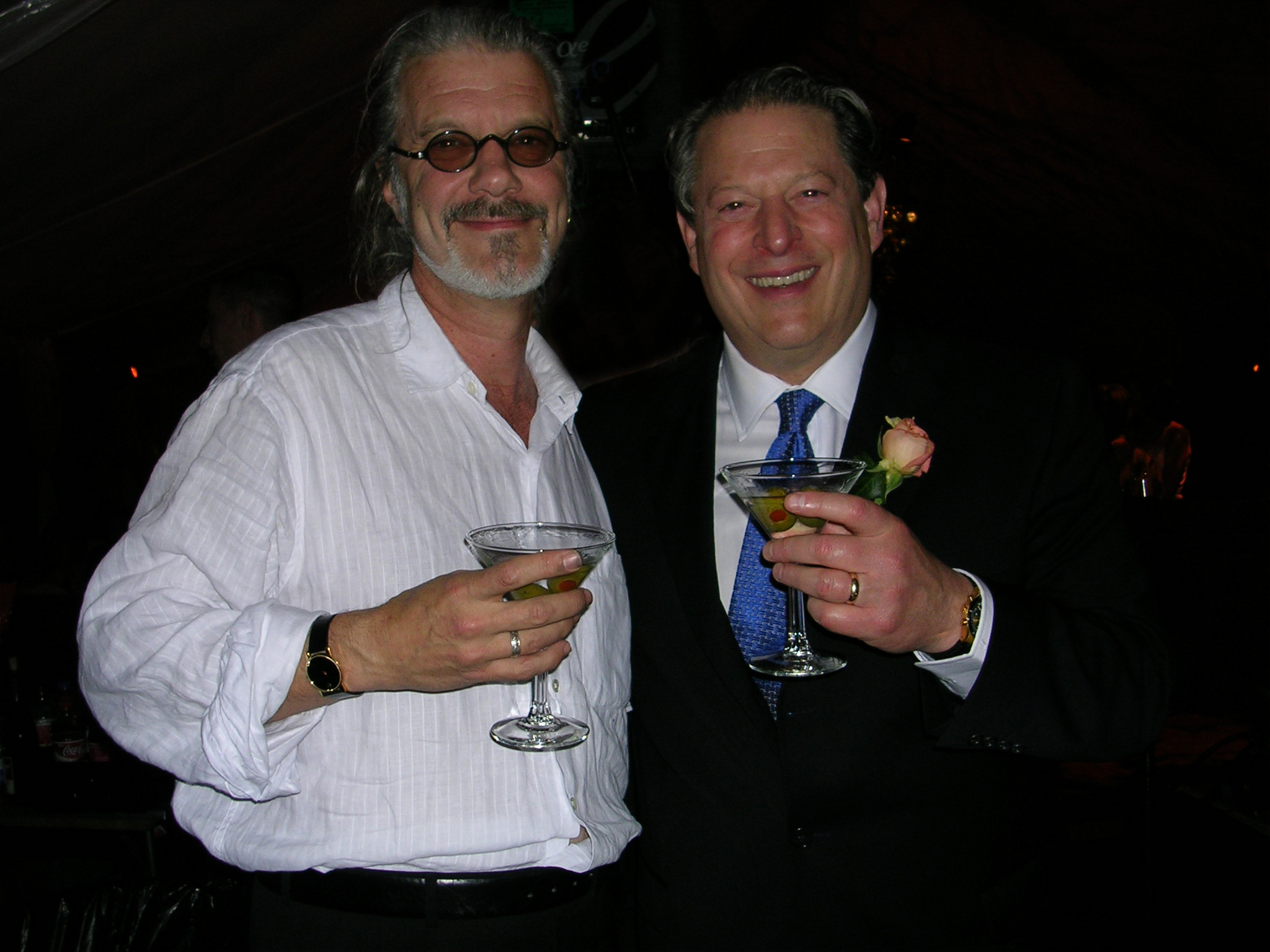
Okay, I recognize the freak but who's
the guy with Al Gore? (If you can answer this question, send me $100.-RAR)
Sam and the Playboys played a wedding for
one of the former VP's gorgeous daughters. He also made those martinis the
boys are seen hoisting in the photo above. There's no end to this guy's
talents. |
| Sam Broussard
MP3: NEW
SAM BROUSSARD! Good
Little Girl - I am so thrilled that Sam has allowed me to stream
this song, which comes from a CD of demo version new compositions. I
haven't been able to get this thing out of my head since I first heard it.
It's rich in images, sexy, human and rhythmic. And listen to Sam's
acoustic guitar work, which to my ear is almost balalaika in approach.
Very imaginative. This is a cool song.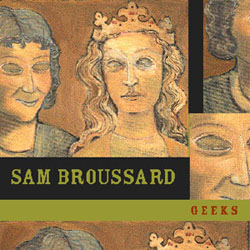
From
Geeks:
I
Don't Care Where You Bury Me
Your
Sleeping Face
Copyright
© Sam Broussard, All Rights Reserved
|
|

Click here
to go
to Sam Broussard's account of playing with guitar great Robben
Ford.
|
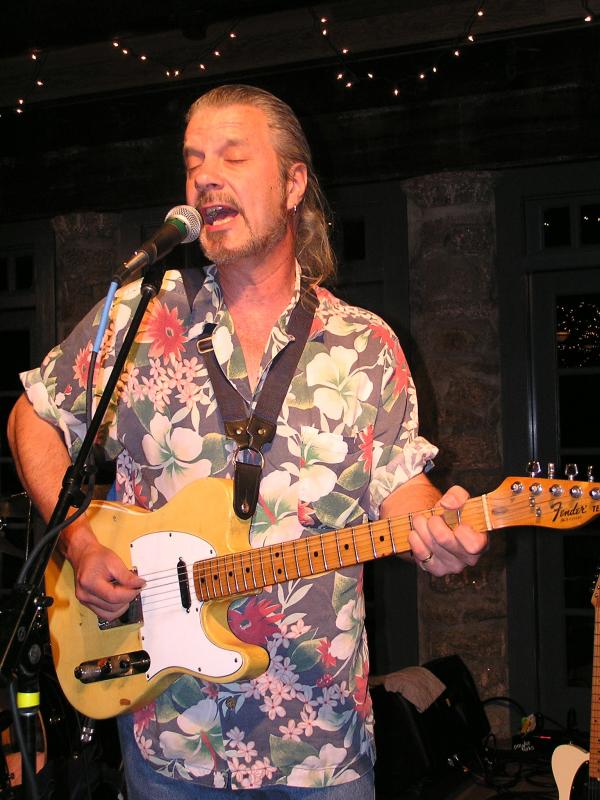
|
|
www.washboardchaz.com
Washboard
Chaz Leary was a much-loved figure on the Boulder music scene, became
a much-loved figure on the New Orleans scene, and after Hurricane Katrina
has become an international phenomenon.
Chaz
and his family were among those impacted by Katrina, and they evacuated to
Oklahoma where they stayed with their old friends the McLerrans for six
weeks. Chaz was then among the first to return to New Orleans, immediately going
back to work lifting spirits with his wonderful music. In March the Washboard
Chaz Blues Trio received international exposure when they backed a Katrina
report by CNN host and correspondent Anderson Cooper. Chaz became
a poster boy for New Orleans' post-Katrina resurgence efforts - an icon of
spiritual indomitability - and with that exposure Chaz' fortunes have
skyrocketed - and for good reason. Listen to the joy in this man's music (MP3s
below). Chaz is being embraced and is touring all over the world . His effort-to-impact ratio is 100 percent; he only has to be heard to connect. We are all
lucky to know this guy. In the world today, riven by events natural and
otherwise, Chaz is more than a Katrina treasure. He's an American treasure.
|
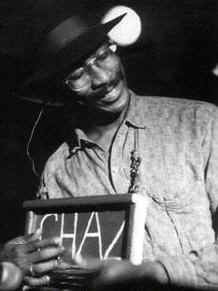
|
|
MP3s
of WASHBOARD CHAZ AND THE TIN MEN:
Drunk
& In Love - From Super
Great Music for Modern Lovers
Jingling
Down the Street - From Freaks For Industry
Hallelujah,
I'm A Bum Again - From Super Great Music for Modern Lovers
Copyright
© Chaz Leary and Tin Men
These
performances are copyrighted and cannot be reproduced or distributed without the
expressed written consent of Chaz Leary and Tin Men.
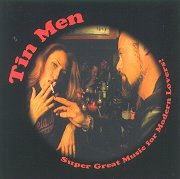
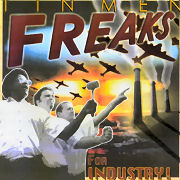 |
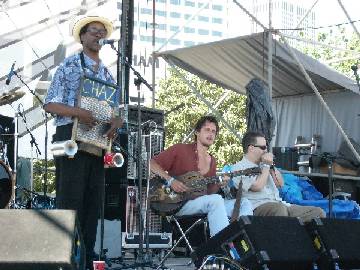 |
|
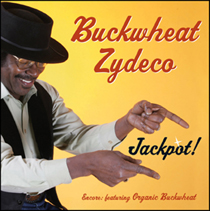
|
www.buckwheatzydeco.com
BUCKWHEAT
Zydeco is enormously popular in the San Francisco Bay Area, featured
regularly when the local mixed format radio station KFOG goes Cajun, which
it does on occassion. "The world's greatest party band,"
as they call themselves, started off as a funk unit before Stanley
"Buckwheat" Dural, Jr. decided to go zydeco 30 years ago. He
had the blueprint, having previously played with Clifton Chenier.
Buckwheat Zydeco has been nominated for a Grammy four times, is among
the Top 50 grossing touring acts in Pollstar, and can claim former Vice
President Al Gore as a fan. Al was turned on to Buckwheat by a
daughter who attended university in New Orleans. The band has played with
the Boston Pops, and Stanley Dural performed duets with Willie Nelson and
Mavis Staples on "Five Card Stud". Eric Clapton was guest on
Buck's version of "Why Does Love Got To Be So Sad?" Buckwheat
played on Keith Richard's solo LP and has jammed with Clapton, Neil Young,
Robert Plant, Ringo Starr, Greg Allman, Jimmy Buffett, John Hiatt, Neville
Brothers, Bonnie Raitt, and Andy Summers, among others. |
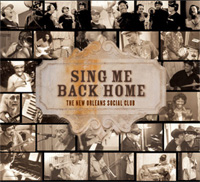 |
THE
NEW ORLEANS SOCIAL CLUB
www.burgundyrecords.com/nosc
Six
weeks after Hurricane Katrina, a group of legendary musicians from New
Orleans gathered in Austin, Texas, to record "Sing Me Back
Home." Over seven magical days and nights, THE NEW ORLEANS SOCIAL
CLUB was born. The collection features performances by members of The
Neville Brothers (Ivan, Cyril and Charles), The Meters (Leo Nocentelli and
George Porter, Jr.), Raymond Weber & Henry Butler. They are joined
by their friends and neighbors Irma Thomas, Marcia Ball, Dr. John,
Willie Tee, Troy (Trombone Shorty) Andrews, the subdudes, the Mighty
Chariots of Fire, Big Chief Monk Boudreaux and John Boutté. |
|
|
|
 |
 |
 |
 |
 |
 |
 |
 |
|
www.spencerbohren.com
Okay,
this is the section of the Links on RARWRITER where a lot of us will experience
feelings of inadequacy. That's right - it's the Spencer Bohren hour!
There isn't
enough real estate on this site to begin to fully profile Spencer's
extraordinary life. There isn't even enough room on his own site! I'm not sure
it could be done in a single book, but here are some highlights.
It goes
something like this: Spencer Bohren
is born in 1950 in Caspar, Wyoming to the Musical Von Trapp Family. Well, not
exactly the Von Trapps, but more of a gospel singing road show of a family from
whom, at an early age, he learns harmonization and love of travel. At age 14 he
wins a Kiwanis-sponsored folk singing competition. At age 17 he graduates from
high school and leaves Wyoming for Denver, Colorado and virtual residency at Harry
Tuft's hallowed Folklore Center
on 17th Street. Spencer forms Eagle-Ridin' Papa with his guitarist friend Don
DeBacker, and they perform country blues. When “eccentric ragtime
genius” The Reverend Gary Davis
makes a week-long tour of Denver, Bohren and DeBacker, working through the
Folklore Center, house “the great blind bluesman,” drive him from
stop-to-stop, and feed off his fecund imagination. By the 1970s, Spencer finds
himself in Oregon playing fiddle and Jimmie Rodgers tunes with the Funston
Brothers, then touring the Pacific Northwest as lead singer for Seattle's Butterfat. He “embrace(s) Hank Williams and swap(s) songs with the
zany Holy Modal Rounders…”
In 1973, Spencer is invited to “join the band of folk-blues
legend Judy Roderick”
so he returns to Colorado and eventually winds up with country-rock band Gone
Johnson. Gone, or Johnson, goes to Los Angeles in search of fortune and
fame, but Spencer keeps blues and folk in his back pocket, which comes in handy
when the disillusioned Spencer decides he must escape the pressures of the awful
business – make that music business – by wondering with his wife
around the country for a year. During his journey he discovers New Orleans. (For
the record, New Orleans was actually discovered, or at least founded, by Sieur
de Bienville. I don’t mean to overstate Spencer’s involvement.) Spencer
returns to solo performing, concentrating on his rich repertoire of original and
traditional songs. Spencer has a baby and soon the Bohrens take up residence in
the Crescent City.
New
Orleans, it turns out, is going through a musical revolution similar (not
musically) to what is going on in the Boulder, Colorado music scene, i.e., a lot
of acts breaking nationally while still mingling with local performers. So,
Spencer is in a cadre that includes The
Neville Brothers, The Radiators,
Beausoleil and the subdudes,
while getting up close and personal experience with New Orleans stalwarts Professor
Longhair, Earl King, Clifton Chenier, and
James Booker. Spencer
positions himself squarely in the mix by hosting a regular jam session at the
famous Tipitina’s. Spencer is also
in virtual residence at “the storied Old Absinthe Bar on Bourbon Street”
where he opens for big-name touring artists and collaborates with NOLA’s
finest players.
Spencer has another baby and soon thereafter makes a decision
to start touring more often, playing more out of town dates than local shows,
but the flow can’t be stanched – Spencer has a third baby (a daughter this
time).
“In 1983, encouraged by friends who traveled with the
circus…” No, seriously! I got that from his website! Spencer refurbishes an
old Airstream trailer (see photograph to the right), hitches it to the back of a
1955 Chevrolet Bel-Air, and heads out to touch Indians (a line I borrowed from Lost
In America, thank you Albert Brooks). It’s like a Forest Gump story.
Spencer and his family start driving and don’t stop for seven years. (Seven
years? Isn’t that Homeric or Biblical or something?) Anyway, Spencer’s long
suffering wife Marilyn, using pay phones as they go, books Spencer into every
paying gig they encounter along the way. They follow the sun, heading north in
summer, south in winter. They home (road?) school their kids.
|
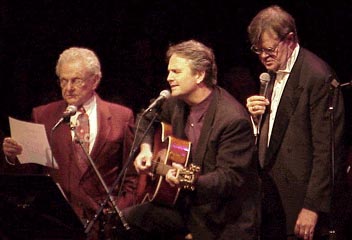  |
| Bluegrass legend
Ralph Stanley, Spencer and Garrison Keillor on Minnesota Public Radio's
"A Prairie Home Companion" in 2001.
Upper
left corner: The Bohren family's 1955 Chevrolet Bel-Air and their
Airstream trailor. They toured America for seven years in that rig, until
the odometer on the Chevy topped 900,000 miles. |
|
The first year out, Spencer cuts his first album, somewhat
bewilderingly titled Born In A
Biscayne. (Weren’t they in a Bel-Air?) Doctor
John plays piano on this LP, the cover shot for which is staged – oh
my god – atop the World Trade
Center! Apparently Scandinavians spot Spencer way up there and invite
him to tour their country, which he does.
Over the next several years, Spencer goes nuts with recording
in the U.S., France, and Sweden and he continues to tour heavily. It
doesn’t make any difference, he still has another baby. The Bohrens
first decide that they need a bigger trailer, but then they just say the
hell with it and get regular accommodations, first in Colorado, then in
Wyoming. But you can’t keep a musical gypsy down, and soon Spencer is
touring in Japan, promoting yet another LP.
Spencer records an American roots LP with harmonica ace JAB
Wilson that refocuses his career back on Americana and Americans. He moves
his family back to New Orleans and cuts a gospel LP, Carry the Word, which the New
Orleans Times-Picayune (picaresque? See a connection here?) name the
"Best CD of the Year 2000 by a Louisiana Artist.”
While viewing a small art show, Spencer has an epiphany –
the art box! Here’s how it is described on his site – “Spencer
assembled an atmospheric scene in a small cigar box, added his own image,
and photographed it for the cover.” (Here’s where Spencer and my life
interests converge. I like to photograph myself “over and over” too,
which is the way I misread his site.) More from the website – “The
process of making art, however, deeply affected Spencer. He created
another box, and then another. These mysterious little boxes quietly
became a consuming passion for Spencer, the recipients of his formidable
creative energy, and an inspirational way to inhabit the lost hours and
stolen moments inherent in the lengthy tours that make up much of a
musician's life…”
Well, okay, I’m having some fun with Spencer, but the art
boxes are beautiful, aren’t they?
Spencer’s art is displayed in university settings and, with
that, a whole other side of Spencer emerges – teacher. He releases Down
the Dirt Road Blues, which in story and song traces the development of
a single blues tune “from 16th Century Africa through America's culture
and history up through the Rolling Stones and Bob Dylan…”
Academia has not completely consumed Spencer Bohren. He
continues to tour extensively, developing strong followings in France,
Belgium, Holland, Sweden, Switzerland, Spain, Italy, Germany, England and
Ireland. And Spencer shows up with Garrison
Keillor and his crew on A
Prairie Home Companion, for which he seems a natural.
And the extraordinary odyssey of Spencer Bohren takes yet
another mythic twist (Remember the prophetic shot of Spencer atop the
World Trade Center?) when his family is evacuated from New Orleans with
the onslaught of Hurricane Katrina. Spencer
updates his fan base from his website on his family’s return to their
New Orleans home.
Take a look at Spencer’s extraordinary site and learn more
about his amazing life as a true troubadour of American music. Spencer is
an amazing guy. |
| Spencer's
available CDs (left to right): The Long Black Line (2006), Down
the Dirt Road Blues (2005), Southern Cross (2004), Solitaire
(2002), Carry the Word (2000), Dirt Roads (1997), Vintage
(1994), Present Tense (1994). This list doesn't include
earlier albums recorded in America and Europe. |
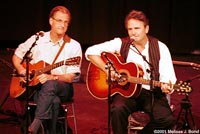 |
 Spencer's previously unavailable
full-length album Full Moon can be downloaded from his site. LEFT:
Spencer on stage with Bay Area favorite Geoff Muldaur Spencer's previously unavailable
full-length album Full Moon can be downloaded from his site. LEFT:
Spencer on stage with Bay Area favorite Geoff Muldaur |
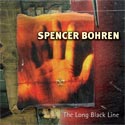 |
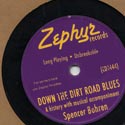 |
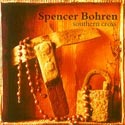 |
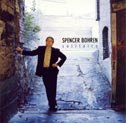 |
| Perhaps
in the future we can provide some MP3s of Spencer Bohren's work for on
line streaming. Please visit Spencer's extraordinary site to listen to
what he has available there. |
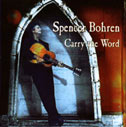 |
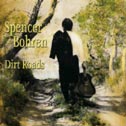 |
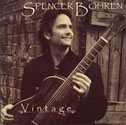 |
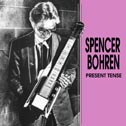 |
Spencer's 2007: 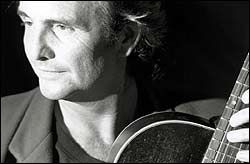 2007
has been expansive thus far for Spencer
Bohren. From flying in to Glasgow to perform at the
Celtic Connections Festival, to producing a CD for New York singer Terrina
Clark, to performing a collaborative show with opera singer Karen Clift,
to opening the Smithsonian's traveling exhibit "New Harmonies"
at the Riley Theatre in Meridian, Mississippi, to a Big Easy award as Best
Folk Artist in New Orleans for 2006 - it's been a full and challenging few
months. |
|
|
|
|
